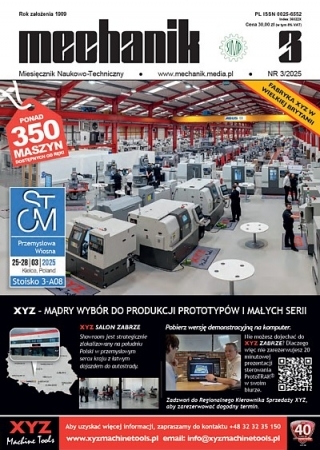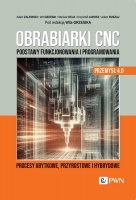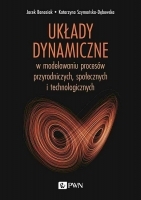Analysis of cutting forces components and surface roughness during sintered carbides turning by tools with diamond edges
Analiza składowych sił skrawania oraz chropowatości powierzchni podczas toczenia węglików spiekanych narzędziami z ostrzami diamentowymi
Mechanik nr 02/2015 - Artykuły z Międzynarodowej Konferencji Innovative Manufacturing Technology IMT 2014 zamieszczone na płycie CD
ABSTRACT: The results of sintered carbides WC-Co turning with different content of cobalt are presented in the work. Particular shafts used for investigation have 25 and 15% Co in their material structure. The inserts with edges made of polycrystalline diamond PCD type of MD220 produced by Mitsubishi company with three different nose radii rε (0.2; 0.4; 0.8 mm) were used while the research of sintered carbides turning. The main idea of research was to show influence of cutting speed, feed and nose radius on Th values of cutting force components and quality surface after a turning process of sintered carbide shafts with the turning length equals 54 mm. The first part of the work presents the characteristics of cutting force components (Ff – feed force, Fp - passive force, Fc - main force) depend on the time of turning process. Based on the analysis of recorded values of cutting forces, it is noticed, the biggest increase is for the passive component of the cutting force Fp and the smallest for the main cutting Fc. This kind of increase for particular cutting force components while WC-Co turning process is caused by hardness of work piece materials, which hardness are above 80 HRA. The structures of work piece material are presented on the suitable pictures obtained by use of scanning microscope. The second part of the work presents the results of surface roughness research for particular obtained surfaces using the portable Mitutoyo profilometer. Particular obtained surfaces were measured six times along the turning path. Based on the results, the influence of a nose radius on the surface quality after the turning process was confirmed, the larger nose radius causes the lower value of surface roughness after a turning process. The last part of the work presents the pictures with particular used inserts, which illustrate state before and after machining process.
KEYWORDS: sintered carbide, WC-Co turning, cutting insert, polycrystalline diamond edge, cutting edge wear, cutting force, surface roughness.
STRESZCZENIE: Artykuł przedstawia wyniki badań procesu toczenia wałków z węglików spiekanych WC-Co o różnej zawartości kobaltu w strukturze materiału. Do badań wykorzystano płytki skrawające z ostrzami diamentowymi typu MD220 firmy Mitsubishi o trzech różnych promieniach zaokrąglenia ostrza (0,2; 0,4; 0,8 mm).
Głównym celem badań było pokazanie wpływu prędkości skrawania, posuwu i promienia zaokrąglenia ostrza na wartości składowych siły skrawania i jakości powierzchni obrobionej po procesie toczenia wałków węglikowych na długości toczenia 54 mm. Na podstawie analizy zarejestrowanych wartości składowych całkowitej siły skrawania, zauważono, że największe wartości zaobserwowano dla składowej odporowej Fp, a najmniejsze dla głównej siły skrawania Fc. Struktury materiału przedmiotu obrabianego zostały zaprezentowane na fotografiach, wykonanych przy pomocy mikroskopu skaningowego. W drugiej części pracy przedstawiono wyniki pomiarów chropowatości powierzchni, wykonanych przy pomocy przenośnego profilografometru Mitutoyo. Zaobserwowano najniższe wartości chropowatości powierzchni po toczeniu ostrzem o największym promieniu zaokrągleniu ostrza.
SŁOWA KLUCZOWE: węgliki spiekane, toczenie WC-Co, płytka skrawająca, ostrze z diamentu polikrystalicznego, zużycie ostrza, siła skrawania, chropowatość powierzchni.
BIBLIOGRAFIA / BIBLIOGRAPHY:
- FRATILA D., Sustainable Manufacturing Through Environmentally-Friendly Machining in Machining in Green Manufacturing Process an Systems Materials Forming. W: Machining and Tribology, 2013. 1-21.
- NEWMAN S.T., NASSEHI A., IMANI-ASRAI R., DHOKIA V., Energy efficient process planning for CNC machining. W: CIRP Journal of Manufacturing Science and Technology 5(2), 2012, 127-136.
- LOPEZ De LACALLE L.N., LAMIKIZ A., FERNANDEZ De LARRINOVA J., Advanced Cutting Tools in Machining of Hard Material, Springer, 2011, 33-85.
- KLOCKE F., Cutting Tool Materials and Tools in Manufacturing Proces, Springer-Verlang, Berlin-Heidelberg, 2011, 95-196.
- BYRNE G., DORNFELD D., DENKENA B., Advancing Cutting Technology. W: CIRP Annals – Manufacturing Technology 52(2), 2003, 483-507.
- GRZESIK W., Machining of Hard Materials in Machining Fundamental and Recent Advanced, Springer, 2008, 97-126.
- ASTAKHOV V.P., Machining of Hard Materials – Definition and Industrial Applications in Machining of Hard Materials, Springer, 2011, 1-32.
- ALMEIDA F.A., FERNANDES A.J.S., SILVA R.F., OLIVEIRA F.J., Semi-orthogonal turning of hardmetal with CVD diamond and PCD inserts at different cutting angles. W: Vacuum 83, 2009, 1215-1223.
- HEO S.J., Environmentally conscious hard turning of cemented carbide materials on the basis of micro-cutting in SEM (2nd report): stress turning with three kinds of cutting tools. W: Journal of Mechanical Science and Technology 23, 2009, 1959-1966.
- JAWORSKA L.: Diament, otrzymywanie i zastosowanie w obróbce skrawaniem, Wydawnictwo Naukowo-Techniczne, Warszawa, 2007.
- HARONO K., SATOH T., SUMIYA H.: Cutting performance of nano-polycrystalline diamond, W: Diamond and Related Materials 24, 2012, 78-82.
- JACKSON M.J., AHMED W., Machining of Brittle Materials Using Nanostructured Diamond Tools in Machining and Nanomaterials, Springer, 2009, 1-30.
- NAKAYAMA K., ARAI M., KANDA T., Machining Characteristics of Hard materials. W: CIRP Annals – Manufacturing Technology 37(1), 1988, 89-92.
- KLOCKE F., Manufacturing Technology – Hard Turning – Hard Roller Burnishing at www.wzl.rwth-aachen.de.
- KLOCKE F., Tool Life Behaviour in Manufacturing Process, Springer-Verlag, Berlin-Heidelberg, 2011, 237-300.
- Catalogue Mitsubishi of inserts for machining sintered carbides.
- ZĘBALA W., KOWALCZYK R., Badania procesu toczenia węglików spiekanych narzędziami z PCD, Instytut Zawansowanych Technologii Wytwarzania, Kraków, 2013, 315-326.
- ZĘBALA W., KOWALCZYK R., Cutting Data Influence on Cutting Forces and Surface Finish During Sintered Carbides Turning. W: Key Engineering Materials 581, 2014, 148-153.
- DANIAVI A., ESKANDARZADE M., TAHMASEBIAN M., Empirical Modeling of Surface Roughness in turning of 1060 steel using Factorial Design Methodology. W: Journal of Applied Sciences 7(17), 2007, 2509-2513.
- SHAH S.C., GEROGE P.M., Surface Roughness Modeling in Precision Turning of Aluminium by Polycrystalline Diamond Tool Using Response Surface Methodology. W: International Journal of Emerging Technology and Advanced Engineering 2(5), 2012, 41-45.




















